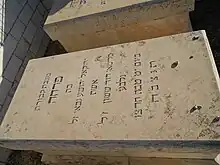Flora Sassoon
Flora Sassoon (18 November 1859 – 14 January 1936) was a Jewish Indian businesswoman, scholar, Hebraist and philanthropist.

Flora Sassoon | |
|---|---|
| Born | Flora (Farha) Gubbay 18 November 1859 Bombay, India |
| Died | 14 January 1936 (aged 76) London |
| Resting place | Mount of Olives Cemetery, Jerusalem |
| Nationality | British |
| Occupation(s) | Hebraist businesswoman Philanthropist |
| Spouse | Solomon David Sassoon |
| Children | 3 ( 1 son + 2 daughter) David Solomon Sassoon Rachel Sassoon (married Sir David Ezra) Mozelle Sassoon |
| Parent(s) | Ezekiel Abraham Aziza Sassoon |
| Relatives | Sassoon family |
Early life
Flora Gubbay was born in 1859 in Bombay, India.[1][2] Her father was Ezekiel Abraham Gubbay (1824–1896), a trader and businessman whom had come to India from Baghdad, Iraq, and her mother was Aziza Sassoon (1839–1897).[1] Her maternal grandfather was Albert Abdullah David Sassoon (1818–1896).[2] As a result, her maternal great-grandfather was David Sassoon (1792–1864), a leading trader of cotton and opium who served as the treasurer of Baghdad between 1817 and 1829, and her maternal great-grandmother was his first wife, Hannah Joseph (1792–1826).[3][4][5] She had five siblings (and half siblings with the first wife of her grand father).[1]
Sassoon went to Catholic school and was also tutored privately from rabbis from Baghdad.[1] By the age of seventeen, she spoke Hebrew, Aramaic, Hindustani, English, French and German.[1] The Cairns Post described her as one of the world's most learned women.[6]
Career and civic activities
Sassoon took over her husband's trading business in India, David Sassoon & Company, shortly after his death.[7]
An observant orthodox Jew, she always travelled with her own prayer quorum of ten Jewish male adults[8] and was a strong supporter of the Balfour Declaration and a staunch zionist.[1] She also studied the Torah and wrote articles about Rashi, who were published in The Jewish Forum.[5][9] In 1924, she presided over the Annual Speech Day at the Jews' College, stressing the importance of a Jewish education. She often hosted Middle Eastern/Indian luncheons and dinners with Jewish cuisine,[1] meticulously prepared following the kashrut standards;[6] to guarantee that, she always travelled with her personal ritual slaughterer.[8]
Whilst living in India, Sassoon was a supporter of Waldemar Haffkine (1860–1930),[10] who invented a vaccine against cholera, and encouraged reluctant Hindus and Muslims to take it. Once she moved to England, she often donated to Jews around the world who appealed to her for money in their hours of need.[1]
Personal life and death
Sassoon married Solomon David Sassoon (1841–1894), the son of David Sassoon (1792–1864) by his second wife, Farha Hyeem (1814–1886); so she married the paternal uncle of her own mother.[3][4][5][11][12] They had three children:
- David Solomon Sassoon (1880–1942; had a son, Solomon David Sassoon (1915–1985), and grandson, Isaac S.D. Sassoon)[2]
- Rachel Sassoon Ezra (1877–1952, married Sir David Ezra)[1]
- Mozelle Sassoon (1884–1921)[1]
They lived in Bombay.[11] After her husband's death, she moved to England.[1][11] She and her children visited Baghdad for the Jewish High Holidays in 1910, and she was introduced by the wali of Baghdad Hussain Nadim Pasha, the Chief Rabbi Ezra Dangoor.[13] There were correspondences in writing between the family and Hakham Joseph Hayyim, the grand sage of Baghdad, revered for his piety and known also by his celebrated work, Ben Ish Hai. The latter died in 1909 and could not have been present for the Sassoon family visit in 1910.
References
- Jewish Women's Archive: Flora Sassoon
- William D. Rubinstein, The Palgrave Dictionary of Anglo-Jewish History, Palgrave Macmillan, 2011, p. 864
- Irene Roth, Cecil Roth, historian without tears: a memoir, Sepher-Hermon Press, 1982, p. 91
- Isaac Landman, The Universal Jewish Encyclopedia ...: An Authoritative and Popular Presentation of Jews and Judaism Since the Earliest Times, 1943, Volume 9, p. 375 [books.google.co.uk/books?id=XZ4YAAAAIAAJ&q="Flora+Sassoon"+1859–1936&dq="Flora+Sassoon"+1859–1936&hl=en&sa=X&ei=-eBYUsijL4Kx0QWKkYC4Dg&ved=0CF0Q6AEwCA]
- Richard Ayoun, Haïm Vidal Séphiha, Séfarades d'hier et d'aujourd'hui: 70 portraits, L. Lévi, 1992, p. 137
- "A Flower Blooms in India". Archived from the original on 16 August 2016. Retrieved 29 July 2016.
- Joan G. Roland, The Jewish Communities of India: Identity in a Colonial Era, Piscataway, New Jersey: Transaction Publishers, 1998, p. 18
- Richard Ayoun, Haïm Vidal Sephiha. Sefardíes de ayer y de hoy: 71 retratos, pp. 146. (in Spanish)
- Michael Kaufman, The Woman in Jewish Law and Tradition, J. Aronson, 1993, p. 81
- Hanhart, Joël (2016). Waldemar Mordekhaï Haffkine (1860-1930). Biographie intellectuelle. Paris: Honoré Champion. ISBN 978-2-7453-3074-1.
- Orpa Slapak, The Jews of India: A Story of Three Communities, UPNE, 1995, p. 38
- Jewish Museum London: Bookplate of Solomon Sassoon
- The Sassoon's Return Visit to Baghdad